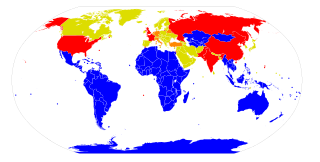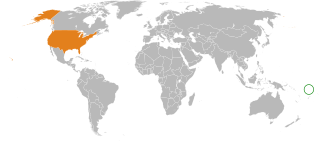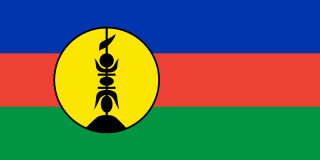
Tuvalu, formerly known as the Ellice Islands, is a Polynesian island country located in the Pacific Ocean, situated in Oceania, about midway between Hawaii and Australia. It lies east-northeast of the Santa Cruz Islands, southeast of Nauru, south of Kiribati, west of Tokelau, northwest of Samoa and Wallis and Futuna, and north of Fiji. It is composed of three reef islands and six true atolls spread out between the latitude of 5° to 10° south and longitude of 176° to 180°, west of the International Date Line. Tuvalu has a population of 10,640. The total land area of the islands of Tuvalu is 26 square kilometres (10 sq mi).

The Pacific Islands Forum (PIF) is an inter-governmental organization that aims to enhance cooperation between countries and territories of the Pacific Ocean. It was founded in 1971 as the South Pacific Forum (SPF), and changed its name in 1999 to "Pacific Islands Forum", so as to be more inclusive of the Forum's Oceania-spanning membership of both north and south Pacific island countries, including Australia. It is an United Nations General Assembly observer.

The Treaty of Rarotonga is the common name for the South Pacific Nuclear Free Zone Treaty, which formalises a Nuclear-Weapon-Free Zone in the South Pacific. The treaty bans the use, testing, and possession of nuclear weapons within the borders of the zone.

The African Nuclear Weapon Free Zone Treaty, also known as the Treaty of Pelindaba, establishes a Nuclear-Weapon-Free Zone in Africa. The treaty was signed in 1996 and came into effect with the 28th ratification on 15 July 2009.

The death penalty has been completely abolished in all European countries except for Belarus and Russia, the latter of which has a moratorium and has not conducted an execution since 1999. The absolute ban on the death penalty is enshrined in both the Charter of Fundamental Rights of the European Union (EU) and two widely adopted protocols of the European Convention on Human Rights of the Council of Europe, and is thus considered a central value. Of all modern European countries, San Marino, Portugal and the Netherlands were the first to abolish capital punishment, whereas only Belarus still practices capital punishment in some form or another. In 2012, Latvia became the last EU Member State to abolish capital punishment in wartime.

Tuvalu – United States relations are bilateral relations between Tuvalu and the United States.
The 1995 Waigani Convention is a treaty that bans the exporting of hazardous or radioactive waste to Pacific Islands Forum countries, and prohibits Forum island countries from importing such waste. The convention has been ratified by Australia, Cook Islands, Fiji, Kiribati, Federated States of Micronesia, New Zealand, Niue, Papua New Guinea, Samoa, Solomon Islands, Tonga, Tuvalu, and Vanuatu. It entered into force in 2001.

The Republic of Vanuatu has been a member of the United Nations since the year of its independence in 1980. The country was a particularly active member in the 1980s, when, governed by Prime Minister Father Walter Lini and represented by Ambassador Robert Van Lierop, it was a consistent advocate for decolonisation. Subsequently, its emphasis within the United Nations shifted to the issue of climate change and the vulnerability of Small Island Developing States.

The Western and Central Pacific Fisheries Commission (WCPFC) is a treaty-based organisation established to conserve and manage tuna and other highly migratory fish stocks across the western and central areas of the Pacific Ocean. Its full name is Commission for the Conservation and Management of Highly Migratory Fish Stocks in the Western and Central Pacific Ocean. It commenced operations in late 2005, and its secretariat is based in Pohnpei, in the northern Pacific state of the Federated States of Micronesia.
The Nauru Agreement Concerning Cooperation in the Management of Fisheries of Common Interest, or The Nauru Agreement is an Oceania subregional agreement between the Federated States of Micronesia, Kiribati, the Marshall Islands, Nauru, Palau, Papua New Guinea, Solomon Islands and Tuvalu. The eight signatories collectively control 25–30% of the world's tuna supply and approximately 60% of the western and central Pacific tuna supply.

The Pacific Islands Forum Fisheries Agency (FFA) is an intergovernmental agency established in 1979 to facilitate regional co-operation and co-ordination on fisheries policies between its member states in order to achieve conservation and optimum utilisation of living marine resources, in particular highly migratory fish stocks, for the benefit of the peoples of the region, in particular the developing countries. The office campus is located in Honiara, Solomon Islands

The Memorandum of Understanding (MoU) for the Conservation of Cetaceans and their Habitats in the Pacific Island Region is a Multilateral Environmental Memorandum of Understanding concluded under the auspices of the Convention on Migratory Species of Wild Animals (CMS), also known as the Bonn Convention, and in collaboration with the Pacific Regional Environment Programme (SPREP). The MoU provides an international framework for coordinated conservation efforts to improve the conservation status of the Pacific Islands Cetaceans and came into effect on 15 September 2006.
The Hostages Convention is a United Nations treaty by which states agree to prohibit and punish hostage taking. The treaty includes definitions of "hostage" and "hostage taking" and sets out the principle of aut dedere aut judicare: a party to the treaty must prosecute a hostage taker if no other state requests extradition for prosecution of the same crime.
The Hague Hijacking Convention is a multilateral treaty by which states agree to prohibit and punish aircraft hijacking. The convention does not apply to customs, law enforcement or military aircraft, thus it applies exclusively to civilian aircraft. The convention only addresses situations in which an aircraft takes off or lands in a place different from its country of registration. The convention sets out the principle of aut dedere aut judicare—that a party to the treaty must prosecute an aircraft hijacker if no other state requests his or her extradition for prosecution of the same crime.
The Protocol for the Suppression of Unlawful Acts against the Safety of Fixed Platforms Located on the Continental Shelf is a multilateral treaty by which states agree to prohibit and punish behaviour which may threaten the safety of offshore fixed platforms, including oil platforms.
The International Convention concerning the Use of Broadcasting in the Cause of Peace is a 1936 League of Nations treaty whereby states agreed to prohibit the use of broadcasting for propaganda or the spreading of false news. It was the first international treaty to bind states to "restrict expression which constituted a threat to international peace and security".
Operation DRIFTNET is the Canadian Armed Forces operation conducted in support of Fisheries and Oceans Canada (DFO). It delivers Canada's participation in multinational efforts to control driftnetting and other forms of illegal, unregulated and unreported fishing in the North Pacific Ocean. Operation DRIFTNET is conducted under a Memorandum of Understanding between DFO and the Department of National Defence.

High Seas Driftnet Fisheries Enforcement Act of 1992 is United States declaration citing an observance of the United Nations international driftnet fishery conservation program to restrict large scale driftnet fishing in high seas or international waters. The Act of Congress acknowledges the United Nations General Assembly Resolutions imposing a global moratorium on all high seas driftnet fishing by December 31, 1992. In accordance with Title 16 section 1857, the United States federal law 102-582 proclaims the Magnuson–Stevens Fishery Conservation and Management Act prohibits the application of large scale driftnet fishing within an exclusive economic zone of any sovereign state and the United States.
The South Pacific Tuna Treaty is a fisheries treaty agreement between the United States and 16 Pacific Island countries. The treaty entered into force in 1988, was extended in 1993, and again in 2002, and runs to 2022, unless otherwise extended. It allows for United States fishing vessels to fish in the exclusive economic zones of the other party states.


















